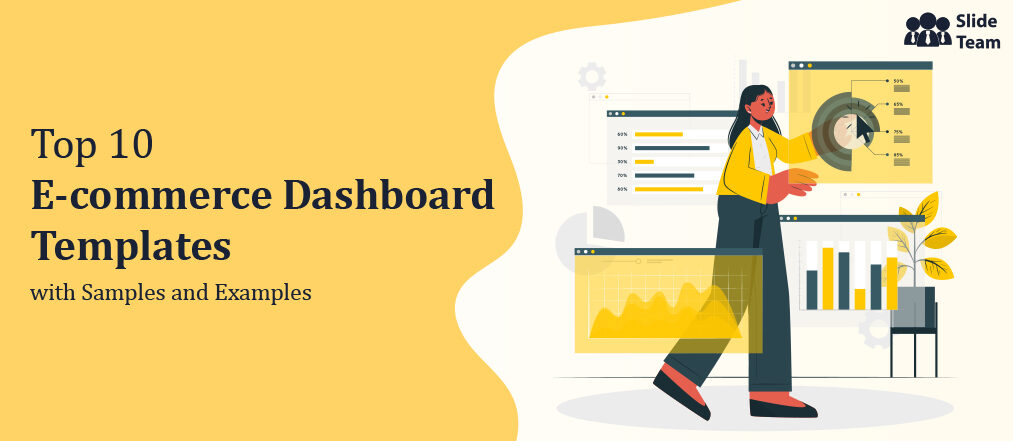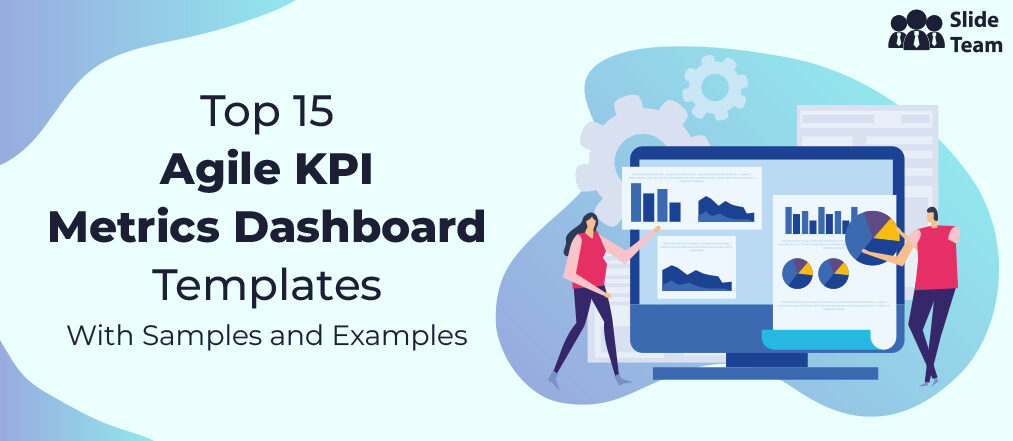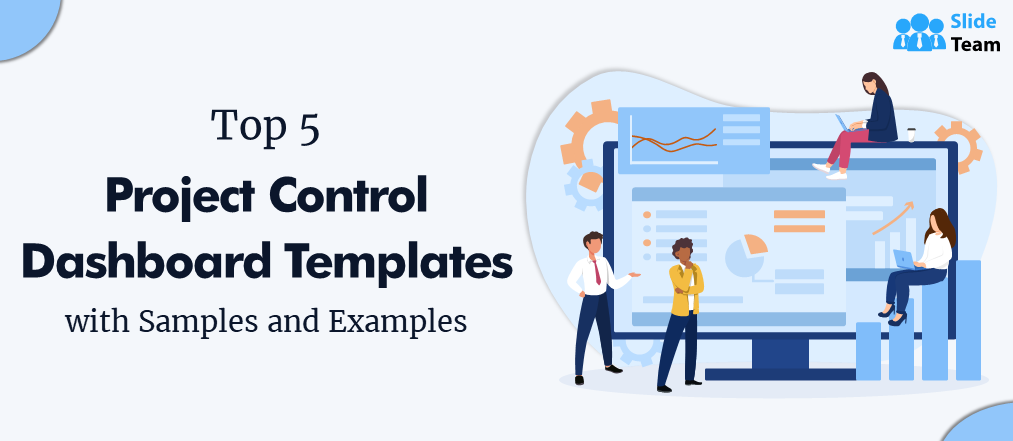With the advent of Amazon and other online delivery services, brick-and-mortar malls are succumbing to their death. A fate not unlike movie theatres after Netflix drove those out of business. With the multiple lockdowns in COVID, online shopping/E-commerce has become the natural choice for millions of people; there is no turning back the habit as well.
Businesses have joined the E-commerce revolution, and you can get almost any product delivered to your home (probably on the same day if you have Amazon Prime!). As you begin moving a significant part of your business online, you need the right tools to gather information and present it to ensure that your online retail venture is working for you. The right tool is a PPT Template.
To help you, we bring you the Top 10 E-commerce Dashboard Templates that are perfect to showcase your progress. Let’s explore the templates now.
Template 1: Digital Business Strategy Ecommerce Management KPI Dashboard Salesforce
Use this PPT Slide to showcase your chosen E-commerce KPIs. Present the company’s salesforce by country, their marketing expenses and sales over the last 30 days, Google Analytics, and more. Download this template now and present an accurate picture of your salesforce.
Template 2: Ecommerce Management KPI Dashboard Lead PPT
Continuing with the theme of Template 1, this PPT Slide will enable you to showcase your E-commerce management. Use it to present the revenue by product, returning vs. new customers, profit & ROI, etc. Get this template now to showcase your progress in finance and win shoppers over.
Template 3: Ecommerce Management KPI Dashboard Salesforce
With a color-coded design, use this PPT Layout to present your salesforce KPIs. Present the average number of orders, sales by product, marketing expenses, and more. Download this template from below.
Template 4: Ecommerce Management KPI Dashboard Sales E-Business Plan
The sequel to Template 3, use this slide to present financial data in sales. Showcase the revenue, profit, ROI, trends, and more. Get this template now to please your top management with the financial Key Performance Indicators (KPIs) that you will monitor.
Template 5: Retailer Dashboard of E-commerce Product Sales
Showcase the KPIs of retail product sales through e-commerce with this PPT Slide. Present the sales, brands, and revenue, and break down data by gender, age, etc. This ensures you can target the right audience at the right time. Download this template to access charts and graphs to depict your data visually.
Template 6: Ecommerce KPIs Dashboard with Site Traffic and Conversion Rate
Showcase the performance of your e-commerce web page using this PPT Dashboard. Present sales, profits, conversion rate, site traffic, the number of transactions, and stakeholders. Download this template now to keep accurate of your business’s online activities. Make sure you progress with the focus on numbers, as digital transformation is a time-consuming exercise.
Template 7: Ecommerce Marketing KPI Dashboard To Analyse Performance
Graphs, charts, and tables; this PPT Template has everything you need to keep your audience engaged as you present your analysis of your e-commerce ventures. All these and more are in this PPT Slide, available for immediate download. Get it now.
Template 8: E-commerce KPIs Dashboard Snapshot Highlighting Monthly Advertisement Cost
Online marketing is radically different than traditional advertising; you need to keep track of your efforts to ensure these don’t go to waste. Use this PowerPoint Dashboard to present a current picture of your advertisement costs and their results. Download it now.
Template 9: E-commerce KPIs Dashboard Depicting Online Product Performance
With a light-mint green color scheme, this PPT Slide will make the presentation a calm and informative event for the audience. Present the performance of your online products with data on sales, average product price, the average number of customers, and more. Make sure you really know the Top-3 numbers that matter for e-retailing. Get it now.
Template 10: E-commerce KPIs Dashboard Illustrating Profit and Roi by Channel
How much have you spent and earned, and how many people have you reached with your e-commerce drive for your products and services? Showcase the answers to these questions and more with this PPT Slide by downloading it from below. Use this template to know the channel efficiency and returns; know these like the back of your hand to ensure you know what sells best and where? This is invaluable knowledge to highlight before a roomful of investors or even your team. Download this PPT Template now.
The Whole World Online
You cannot enter a new avenue in business without the right tools to back you up. With our E-commerce Dashboard Templates, you will be able to make your online business just as successful as your offline business. Download these now as you enter this online arena.
P.S. To understand the impact your business has on the market and more, click here to download the perfect PPT Templates to run and present this analysis.
FAQs on E-commerce
What is e-commerce? Give an example.
E-commerce, short for electronic commerce, refers to the buying and selling of goods and services over the internet. An example of e-commerce is Amazon, an online marketplace that allows people to buy and sell a wide range of products. Other examples of e-commerce include eBay, an online auction site, and Alibaba, a global retail platform.
What are the three types of e-commerce?
There are generally three types of e-commerce: business-to-consumer (B2C), consumer-to-consumer (C2C), and business-to-business (B2B):
- Business-to-consumer (B2C) e-commerce refers to the online sale of goods or services from a business to an individual consumer.
- Consumer-to-consumer (C2C) e-commerce refers to the online sale of goods or services from one individual consumer to another.
- Business-to-business (B2B) e-commerce refers to the online sale of goods or services from one business to another.
What are the 4 types of e-commerce?
There are generally four types of e-commerce: business-to-consumer (B2C), consumer-to-consumer (C2C), business-to-business (B2B), and consumer-to-business (C2B):
- Business-to-consumer (B2C) e-commerce refers to the online sale of goods or services from a business to an individual consumer.
- Consumer-to-consumer (C2C) e-commerce refers to the online sale of goods or services from one individual consumer to another.
- Business-to-business (B2B) e-commerce refers to the online sale of goods or services from one business to another.
- Consumer-to-business (C2B) e-commerce refers to the online sale of goods or services from an individual consumer to a business.
What are the 8 types of e-commerce?
Some common types of e-commerce include the following:
- Business-to-consumer (B2C) e-commerce refers to the online sale of goods or services from a business to an individual consumer.
- Consumer-to-consumer (C2C) e-commerce refers to the online sale of goods or services from one individual consumer to another.
- Business-to-business (B2B) e-commerce refers to the online sale of goods or services from one business to another.
- Consumer-to-business (C2B) e-commerce refers to the online sale of goods or services from an individual consumer to a business.
- Mobile commerce (m-commerce) refers to the use of mobile devices, such as smartphones and tablets, to engage in e-commerce.
- Social commerce refers to the use of social media platforms, such as Facebook and Instagram, to engage in e-commerce.
- Electronic funds transfer (EFT) refers to the electronic transfer of money from one bank account to another without the use of physical cash or checks. This is often used in e-commerce transactions to facilitate the payment process.
- Electronic data interchange (EDI) refers to the electronic exchange of business documents, such as invoices and purchase orders, between organizations. This is often used in B2B e-commerce to streamline the transaction process.
What are the benefits of e-commerce?
E-commerce, or electronic commerce, refers to the buying and selling of goods and services over the internet. There are several benefits to e-commerce, including:
- Convenience: E-commerce allows people to shop online from the comfort of their own homes at any time of day or night.
- Increased accessibility: E-commerce makes it easy for people to access a wider range of products and services, even if they live in a remote or rural area.
- Lower prices: E-commerce allows businesses to operate more efficiently, which can lead to lower prices for consumers.
- Greater competition: The ease of starting an online business means that there is often more competition in the e-commerce market, which can drive prices down and increase the quality of products and services.
- Better customer service: Many e-commerce businesses offer excellent customer service, with features like live chat and easy returns.
- More personalized shopping experiences: E-commerce businesses can use data and technology to offer personalized recommendations and tailor their products and services to individual customers.





 Customer Reviews
Customer Reviews



























